

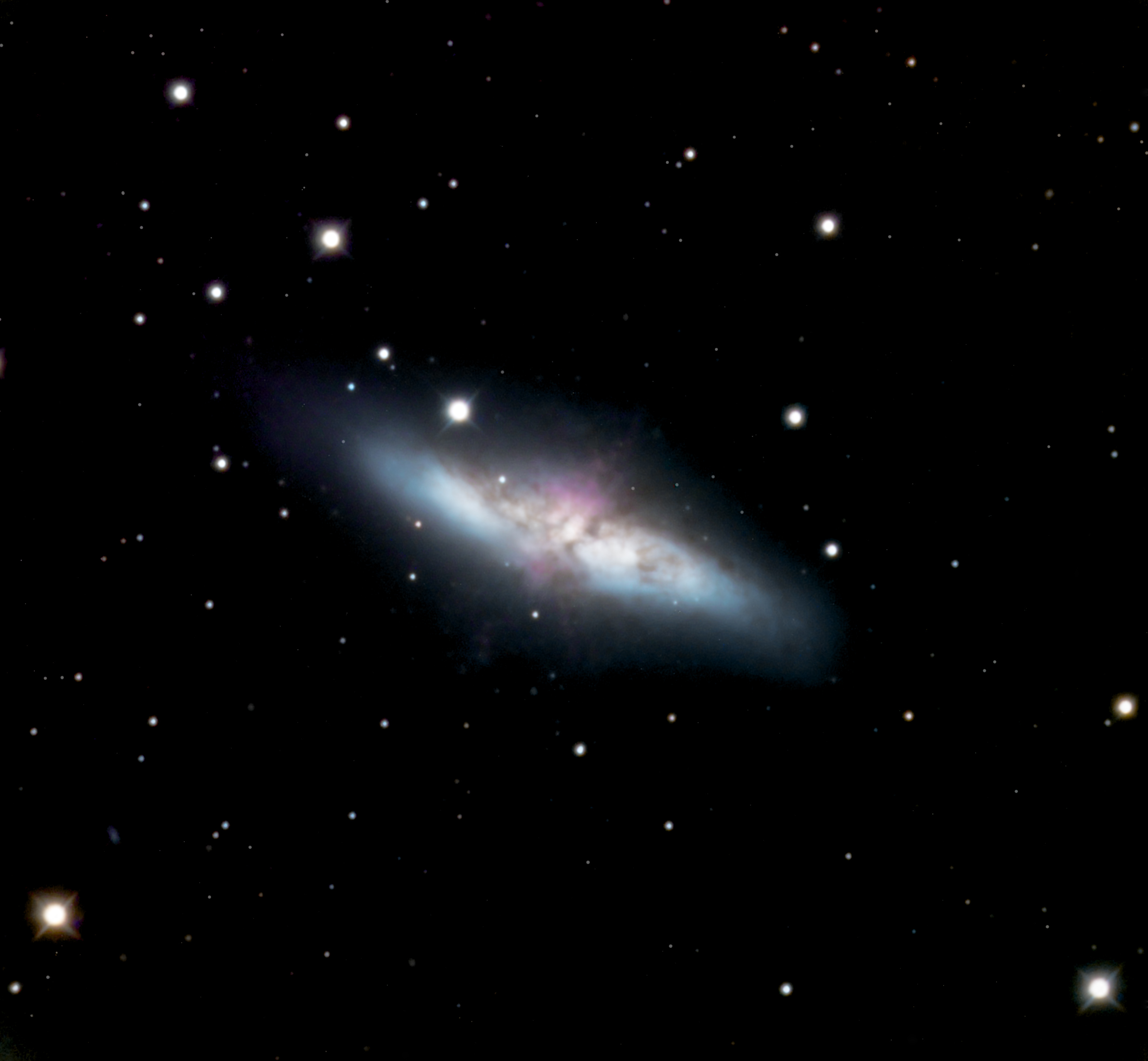
Remotely Operated Telescopes
Click on an Image for a Larger View
| NGC 5128 - Centaurus A Centaurus A is a galaxy that was discovered in 1826 bt a Scottish astronomer by the name of James Dunlop. Astronomers are still aguing about whether it is a lenticular or a giant elliptical galaxy. It's distance is roughly 12 million light-years away from us. It is a strong radio source as well as having very strong x-ray jets shooting out perpendicular to its galactic plane. It also has, at its center, a super-massive black hole that weighs in at about 55 million solar masses. This is my second image taken with Telescope.live.com remotely operated telescopes. It's a real joy to work with such good raw data. Image processed by Ron Yelton, original data from Telescope Live |
Messier
83 (NGC 5236) - The Southern Pinwheel Galaxy This galaxy was discovered by Louis de Lacaille in 1752 and added to the Messier catalog in 1781. It is one of the closest and brightest galaxies in our night sky. It is classified as a Grand Design Spiral Galaxy and is very active in its star formation along the outer spirals. This image was taken using the Telescope Live CHI-1 telescope in Chile. Image processed by Ron Yelton, original data from Telescope Live |
Messier 82 (NGC 3034) - The
Cigar Galaxy M 82 is located up in the north in Ursa Major. It is classified as a Starburst Galaxy. Its core area is about 5 times the luminosity of the entire Milky Way Galaxy. The starbust designation is probably due to interaction with nearby Messier 81 (M 81). It is part of our local group of galaxies. This was one of the first images I did with Telescope Live in late 2019. The telescope, SPA-2, has a square chip in the camera, but the filters were round, giving its images a terrible vignetting problem. The sub frames weren't the best so I had to crop almost half of the image. This is my first attempt at blending Ha data with a standard RGB image. It still has some issues to resolve, which I'll fix as soon as I learn how to do a couple of other procedures in Photoshop, Image processed by Ron Yelton, original data from Telescope Live |
|
Location: El Sauce Observatory, Chile Date: December 31, 2019 Mount: Mathis MI-1000 Telescope: Planewave CDK24 f/6.6 Camera: FLI PL9000 @ -25c (CHI-1) Exposure: 6 x 10min each for LRGB. Total: 1 hr. |
Location: El Sauce
Observatory, Chile
Date: August 9,2020 Mount: Mathis MI-1000 Telescope: Planewave CDK24 f/6.6 Camera: FLI PL9000 @ -25c (CHI-1) Exposure: 6 x 10min each for LRGB. Total: 1 hr. |
Location: IC Astronomy Obs, Spain Date: December 30, 2019 Mount: OS EQ Telescope: Officina Stellare ProRC 700 Camera: FLI PL16803 @ -25C (SPA-2) Exposure: LRGB 6 x 10 min / Ha 8 x 10 min Total: 1 hr |
 |
 |
 |
| NGC
6744 This galaxy lies about 30 million light-years away in the southern constellation of Pavo and is about 170,000 light-years across. it is an intermediate galaxy which means that is in-between a barred and an unbarred galaxy (the bar stretching across the center of the galaxy). This data set was provided by Dan Crowson, an excellent astrophotographer. He has the data set for one of my objects and he sent this one to me. Definitely a win-win trade. As I was finishing up with the processing for this image, I zoomed in quite close and counted 108 smaller galaxies scattered throughout the image. Wow! Image processed by Ron Yelton, original data from Telescope Live |
NGC
2442 - The Meathook Galaxy Discovered by John Herschel in 1834, the Meathook Galaxy is about 50 million light-years away from us in the constellation Volans in the southern hemisphere. The galaxy has been deformed by a near miss with another passing galaxy sometime in the past. This near miss probably caused intense star formation in the bottom, long arm. Image processed by Ron Yelton, original data from Telescope Live |
Messier
88 Discovered by Charles Messier in 1781, M 88 lies about 50-60 LYs away.M 88 is also part of the Virgo Galaxy Cluster. Image processed by Ron Yelton, original data from Telescope Live |
|
Location: El Sauce Observatory, Chile Date: August 14, 2020 Mount: Mathis MI-1000 Telescope: Planewave CDK24 f/6.6 Camera: FLI PL9000 @ -25c (CHI-1) Exposure: 8 x 5min each for LRGB. Total: 40min. |
Location: El
Sauce Observatory, Chile
Date: January 10, 2021 Mount: Mathis MI-1000 Telescope: Planewave CDK24 f/6.6 Camera: FLI PL9000 @ -25c (CHI-1) Exposure: 6 x 10min each for RGB. Total: 1 hr. |
Location: El Sauce Observatory, Chile
Date: February 8, 2020 Mount: Mathis MI-1000 Telescope: Planewave CDK24 f/6.6 Camera: FLI PL9000 @ -25c (CHI-1) Exposure: 6 x 10min each for RGB. Total: 1 hr. |
 |
 |
 |
| NGC
4038-39 The Antennae Galaxies Known as the Antennae Galaxies, these two interacting galaxies (IAGs) were discovered in the constellation Corvus by William Herschel back in 1785. The two galaxies are in the process of colliding, and as a result, the pressure waves from colliding clouds of gas, dust and magnetic fields has resulted in rapid star formation (known as a Starburst Galaxy) and massive globular clusters. This also has resulted in five supernovae that we know of in 1921, 1974, 2004, 2007 and 2013. This image was put together using six imaging sessions ranging from March through July 2021. They are called the Antennae Galaxies because of the long tidal trails. Image processed by Ron Yelton. Original data from Telescope Live |
NGC 6946 - The Fireworks
Galaxy This is the first image that I've completed with PixInsight, a very powerful astro image processing piece of software. All of the subs were provided by Adam Block as a downloadable data set that is part of his instructional video tutorials. All of the subs were taken through Telescope Live with the Planewave 24" RC telescope (CHI-1) in Chile. The Fireworks Galaxy is a face-on spiral galaxy that lies about 25 Mly away. It was discovered by William Herschel in 1798. It's part of the Virgo Super Cluster of Galaxies. Image Processed by Ron Yelton, Original Data from Adam Block / Telescope Live |
Telescope Live Back in 2019, shortly after I signed up as a customer, I submitted my first image to their gallery - NGC 5128 (Centaurus A). Shortly after that, their director of Marketing sent me an e-mail asking if they could use that image in an advertisement in an english astronomy magazine. Of course I said yes. Her is a link to the article. I have been officially published - YAY! Astronomy Now Magazine Ad |
|
Location: El Sauce Observatory, Chile Date: March-July 2021 Mount: Mathis MI-1000 Telescope: Planewave CDK24 f/6.6 Camera: FLI PL9000 @ -25c (CHI-1) Exposure: 8 x 5min each for LRGB. Total: 40min. |
Location: El Sauce
Observatory, Chile
Date: Unknown Mount: Mathis MI-1000 Telescope: Planewave CDK24 f/6.6 Camera: FLI PL9000 @ -25c (CHI-1) Exposure: 7 x 10min each for LRGB. Total 1hr 10min |
Telescope Live
When I attended the Advanced Imaging Conference in 2022, I stopped in at the vendors area to say hi to Marco at Telescope Live. I have been one of their earliest and active customers and they had a gift for me - a thank you card that was made from my posted image of the Rosette Nebula and a bottle of Italian Chianti (he lives in Italy). Mentore asked if i would say a few words about T.L. for their website blog. Here it is. Ron's Telescope Live Interview |
 |
 |
| Messier 31 (M31) The Andromeda Galaxy Lying about 2.5 million light-years from Earth, the Andromeda Galaxy is about 152,000 light-years across. it is the nearest galaxy to out own Milky Way. It can be viewed with the naked eye in even slightly light polluted skies. The Andromeda Galaxy is moving toward us and will collide with the Milky Way in about 4-5 billion years, forming either an elliptical or lenticular galaxy. It is one of the brightest Messier objects. Image processed by Ron Yelton. Original data from Telescope Live Observation Bundle |
NGC 3614 NGC 3614 is a barred spiral galaxy in Ursa Major. Right next to it is what is believed to be a remnant companion galaxy. In Adam's tutorial he shows how to bring out two tidal streams from the galaxy, but I just wasn't able to accomplish that with my level of expertise in PixInsight processing. Still, it's a pretty cool galaxy. Original data by Adam Block from the Cosmic Canvas collection. Processing by Ron Yelton |
Messier 31 (M31) The Andromeda Galaxy Another view of the Andromeda Galaxy. This time exploring the center of the galaxy with the 27" Officina Stellare ProRC 700 in Oria, Spain. This galaxy is so bright that you can see it with the naked eye on a clear, dark night. Hence the bright. Image processed by Ron Yelton. Original data from Telescope Livecenter. |
|
Location: IC
Astronomy
Observatory, Date: September - December 2021 Mount: Paramount MX+ Telescope: Takahashi ESQ-106ED (SPA-1) Camera: FLI PL 16083 Exposure: 34 x 30min each for LRGB. Total: 10 hrs |
Location:
Steward Observatory, Mount
Lemmon
Date: February 2015 Mount: Telescope: Schulman Camera: Exposure: |
Location: IC Astronomy Obs,
Spain Date: Nov 2020-Dec 2021 Mount: OS EQ Telescope: Officina Stellare ProRC 700 Camera: FLI PL16803 @ -25C (SPA-2) Exposure: RGB 10 x 2 min Total: 20 min |
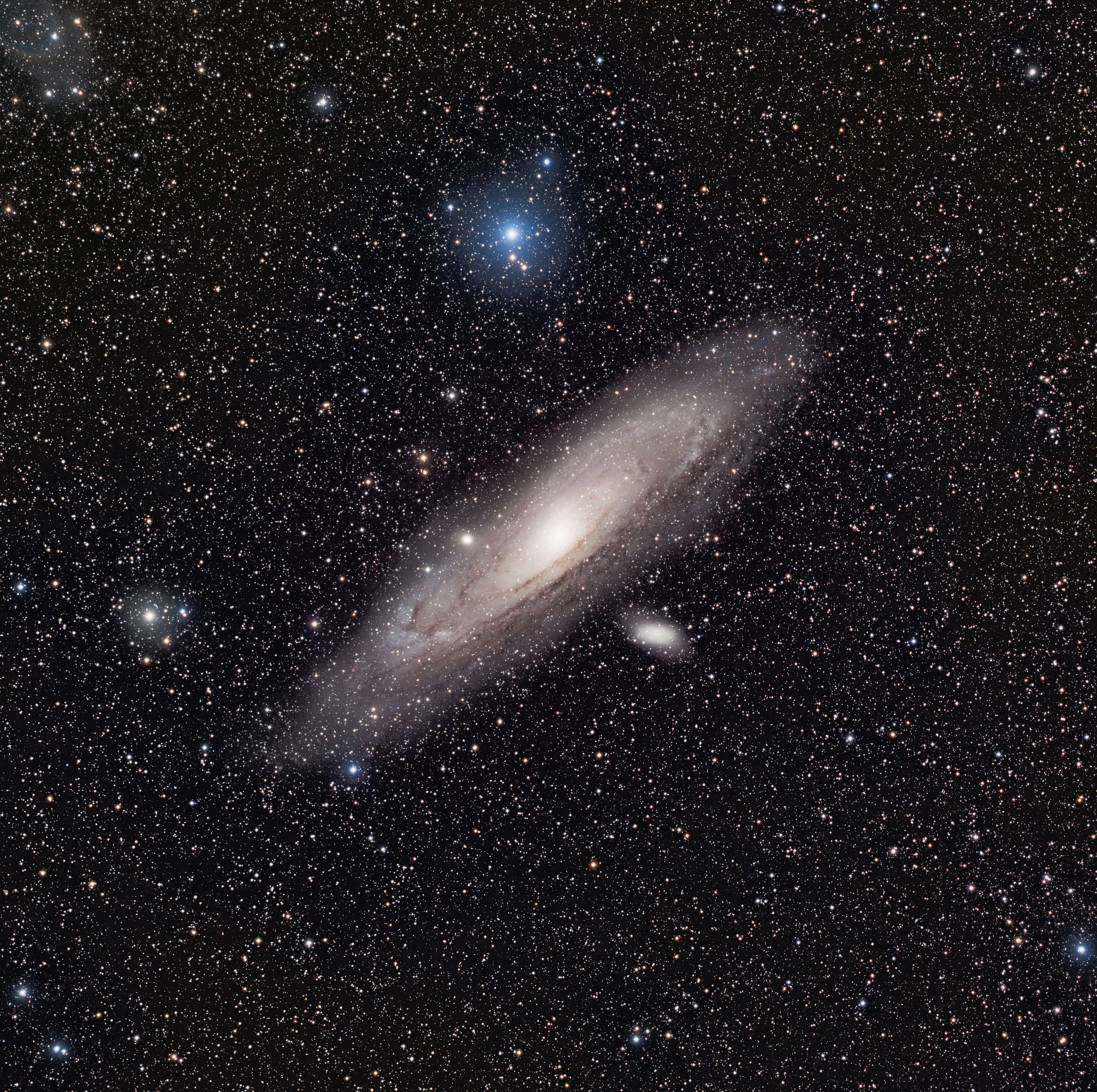 |
 |
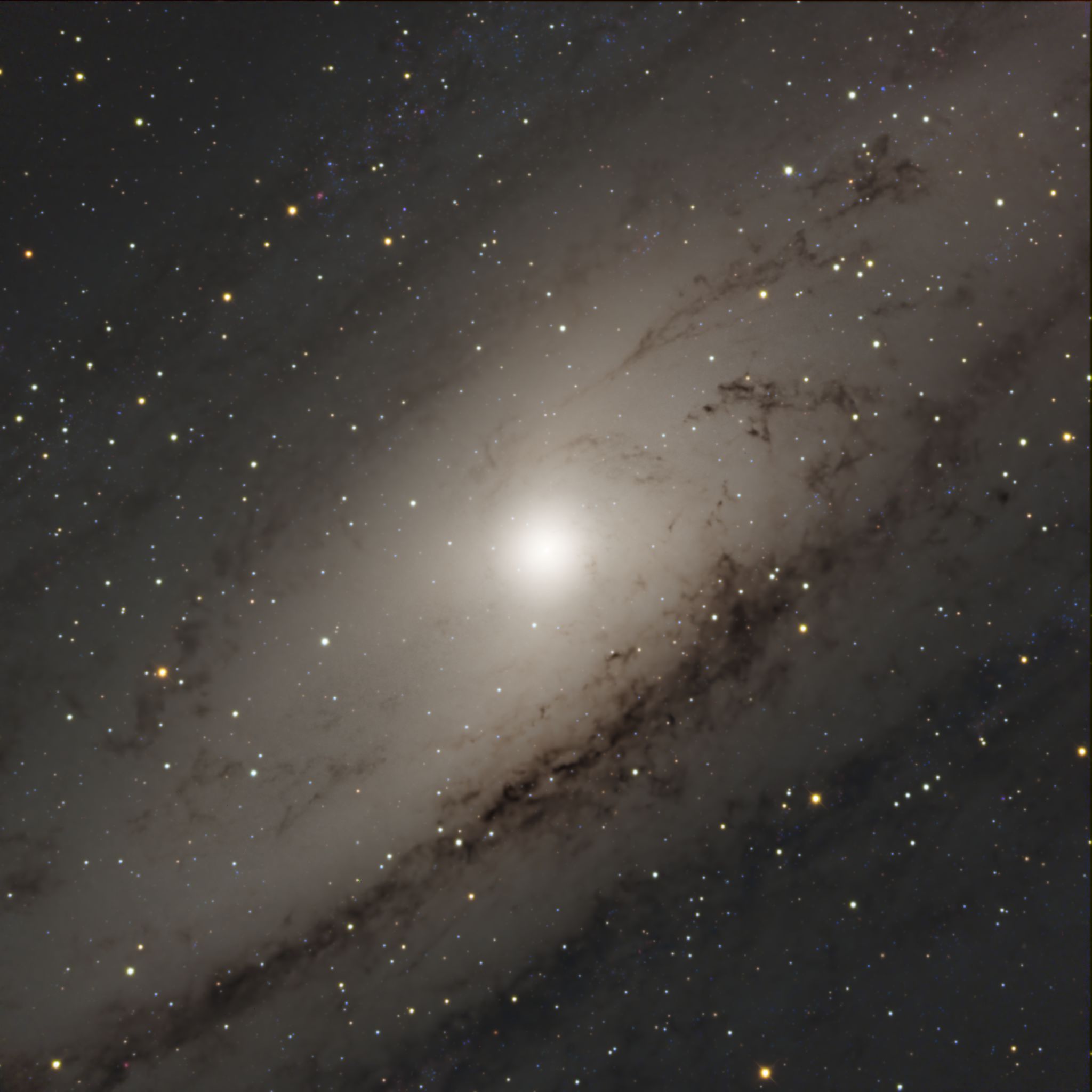 |
| NGC 1365 - The Great Barred Galaxy In the southern constellation of Fornax, lies The Great Barred Spiral Galaxy. It is a double barred galaxy that sits about 56.2 million light-years away from us. The distance from the tips of the spiral arms is around 200,000 light-years. The inner bar structure (the brighter area in the center) rotates at a faster rate that the larger long bar, while the outer arms take about 350 million years to make a full rotation. In the center of the galaxy is a super-massive black hole that is estimates to weigh in at about 2 million solar masses and rotates just under the speed of light. Image processed by Ron Yelton. Original data from Telescope Live |
NGC 253 - The Sculptor Galaxy This galaxy goes by many names: The Sculptor Galaxy, The Silver Dollar Galaxy, NGC 253 and Caldwell 65. It's an intermediate spiral galaxy in the constellation of Sculptor. It was discovered by Caroline Herschel in 1783 while she was doing a systematic comet search. It's bright enough to view with binoculars and is considered to be the second most viewed galaxy behind the Andromeda Galaxy. This galaxy is in a starburst phase - that is, there is a considerable amount of star nurseries. By analyzing the spectra of the materials in this galaxy, it is thought that a gas-rich dwarf galaxy collided with it about 200 million years ago. there also seems to be a black hole at its center that is about 5 million solar masses. Image processed by Ron Yelton. Original data from Telescope Live |
NGC
4565 - The
Needle Galaxy
This edge-on galaxy is in the constellation Coma Berenices, in the heart of galaxy country. It is estimated to be about 13 billion years old and is about 45 MLYs away. It is more luminous than the Andromeda Galaxy and is thought to be a giant spiral galaxy. It is also interacting with two companion galaxies, and can boast 240 globular clusters - more than what is in the Milky Way. I zoomed in quite a bit and counted 114 other smaller, distant galaxies I've included two slightly different versions of the galaxy. The difference being that in the second image the sky background is slightly darker which brings out the colors and details a bit more. Be aware that the darker background is darker than the natural brightness of the sky. So that makes it a bit unnatural. :) During the final clean-up of this image I counted 214 additional galaxies in the field. Image processed by Ron Yelton. Original data from Telescope Live |
|
Location: El
Sauce Observatory, Chile Date: December 12, 2021 Mount: ASA Alt-Az Direct Drive Mount Telescope: ASA RC-1000AZ Camera: FLI PL16803 @ - 25c (CHI-3) Exposure: 7 x 5min RGB Total: 1hr 5 min |
Location: El
Sauce Observatory, Chile
Date: August 14, 2021 Mount: Mathis MI-1000 Telescope: Planewave CDK24 f/6.6 Camera: FLI PL9000 @ -25c (CHI-1) Exposure: 6 x 10min RGB Total: 1hr |
Location: El Sauce Observatory, Chile Date: Jun21-Mar23 Mount: Mathis MI-1000 Telescope: Planewave CDK24 f/6.6 Camera: QHY600m @ -25c (CHI-1) (CMOS) Exposure: 18 x 5 min LRGB Total: 1.5 hrs |
 |
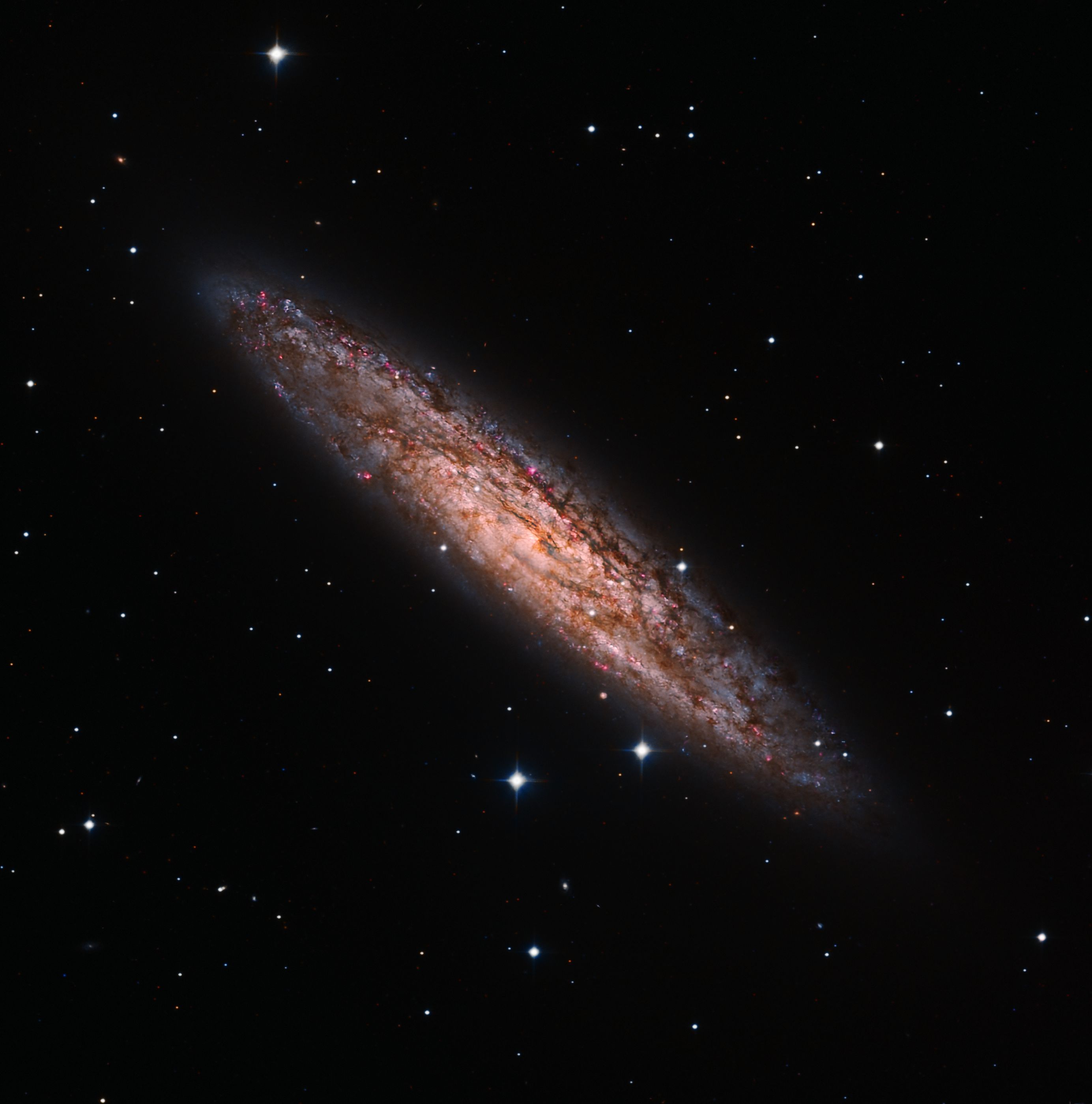 |
 |
| NGC 4565
- The Needle
Galaxy In this second image of The Needle Galaxy I darkened the sky background more than usual in order to bring out more of its natural color and detail. Since the sky is darker than its natural brightness, it should be noted that this image isn't a true representation of the object. Image processed by Ron Yelton. Original data from Telescope Live |
Messier 83 -
The Southern
Pinwheel
Galaxy M 83 is a Grand Design Spiral Galaxy with loosely wound spiral arms. The nearby dwarf galaxy NGC 5253 most likely interacted with M 83 within the last billion years which would explain the massive star making activity along the forward edges of the spiral arms. This is truly a huge galaxy, with a diameter of 118,000 light-years. It is also one of the brightest and closest objects (15 MLY) in our local night sky. It was discovered by Nicolas-Louis de Lacaille in 1752 at the Cape of Good Hope. Charles Messier added it to his catalog of nebulous objects, now the Messier Catalog in 1781. I originally did this object back in 2020 with CCDStack and Photoshop (see top of page), and this is my first re-do with Pixinsight. Image processed by Ron Yelton. Original data from Telescope Live |
NGC
3628 -
The Hamburger
Galaxy Lying around 35 million light-years away, is this unbarred spiral galaxy. It was discovered in 17584 by William Herschel. It's most noted feature is the dark band of dust and gas that splits the top and bottom halves. It has an X-shaped cental bulge which is indicative of a barred spiral. simulations show that bars often form in disk galaxies when they interact or merge with other galaxies, as it does with nearby M65 and M66. NGC 3528 is also part of the Leo triplet. Image processed by Ron Yelton. Original data from Telescope Live |
|
Location: El Sauce Observatory, Chile Date: Jun21-Mar23 Mount: Mathis MI-1000 Telescope: Planewave CDK24 f/6.6 Camera: QHY600m @ -25c (CHI-1) (CMOS) Exposure: 18 x 5 min LRGB Total: 1.5 hrs |
Location: El Sauce Observatory, Chile
Date: April 13-17, 2023 Mount: Mathis MI-1000 Telescope: Planewave CDK24 f/6.6 Camera: QHY600m @ -25c (CHI-1) (CMOS) Exposure: 18 x 5 min LRGB Total: 1.5 hrs |
Location: El Sauce
Observatory, Chile Date: March 2021 - March 2023 Mount: Mathis MI-1000 Telescope: Planewave CDK24 f/6.6 Camera: QHY600m @ -25c (CHI-1) (CMOS) Exposure: 12 x 5 min LRGB Total: 1 hr |
 |
 |
 |
| Image
Slideshow with
Music - May
2023 This was a fun project to do. I selected some of my favorite images (both from my own rig as well as from Telescope Live) and added a sound track of original music. It's a large file - more than AOL will let me send. So, here are a couple of links - one to download the file and one to wtch the presentation here on the website. I hope you enjoy it! Both links should work just fine with any browser - except Firefox The Video version has a couple of glitches in the sound track and video that I could not fix. Sorry. Watch Video Images Slideshow with Original Music - May 2023 The Powerpoint version has a clean sound track and video. Once the file is downloaded, open it, select Slideshow at the top and then select Start from beginning on the left. It may start in Presenter's View, Look for a round circle. This will have the option to turn off Presenter's View. Download Powerpoint Images Slideshow with Original Music - May 2023 |
NGC 3621 This galaxy is located in the constellation Hydra and lies about 22 million light-years away. It's diameter is about 93,000 light-years across. It's a flat-disc galaxy - in that it doesn't have a central bulge. This is unusual since galaxies that have black holes at their center almost always have a central bulge. There is thought to be one super-massive black hole (20,000 times the mass of our Sun) and two smaller companion black holes at it's center. Telescope live has upgraded all of the cameras on their telescopes. The new CMOS cameras have their own set of processing challenges that are different from the old CCD cameras. Image processed by Ron Yelton. Original data from Telescope Live |
Messier 51
One of the most popular objects of both amateur and professional astronomers, Messier 51 (M51), the Whirlpool Galaxy, was first discovered in 1773 by Charles Messier. Its companion galaxy (NGC 5195) was discovered in 1781 by Pierre Mechain. These two galaxies are interacting (merging) and have already collided at least twice. Estimated distance is about 37 million light years. Image processed by Ron Yelton. Original data from Telescope Live |
|
Location:
El Sauce
Observatory, Chile Date: March 2021 - March 2023 Mount: Mathis MI-1000 Telescope: Planewave CDK24 f/6.6 Camera: QHY600m @ -25c (CHI-1) (CMOS) Exposure: 12 x 5 min LRGB Total: 1 hr |
Location: IC Astronomy Obs, Spain
Date: April 23-25, 2023 Mount: Officina Stellare Eq Fork Telescope: Officina Stellare ProRC 700 (5600mm) Camera: QHY600m @ -30 (SPA-2) (CMOS) Exposure: 71 x 120sec ea LRGB = 2 hrs 22 min |
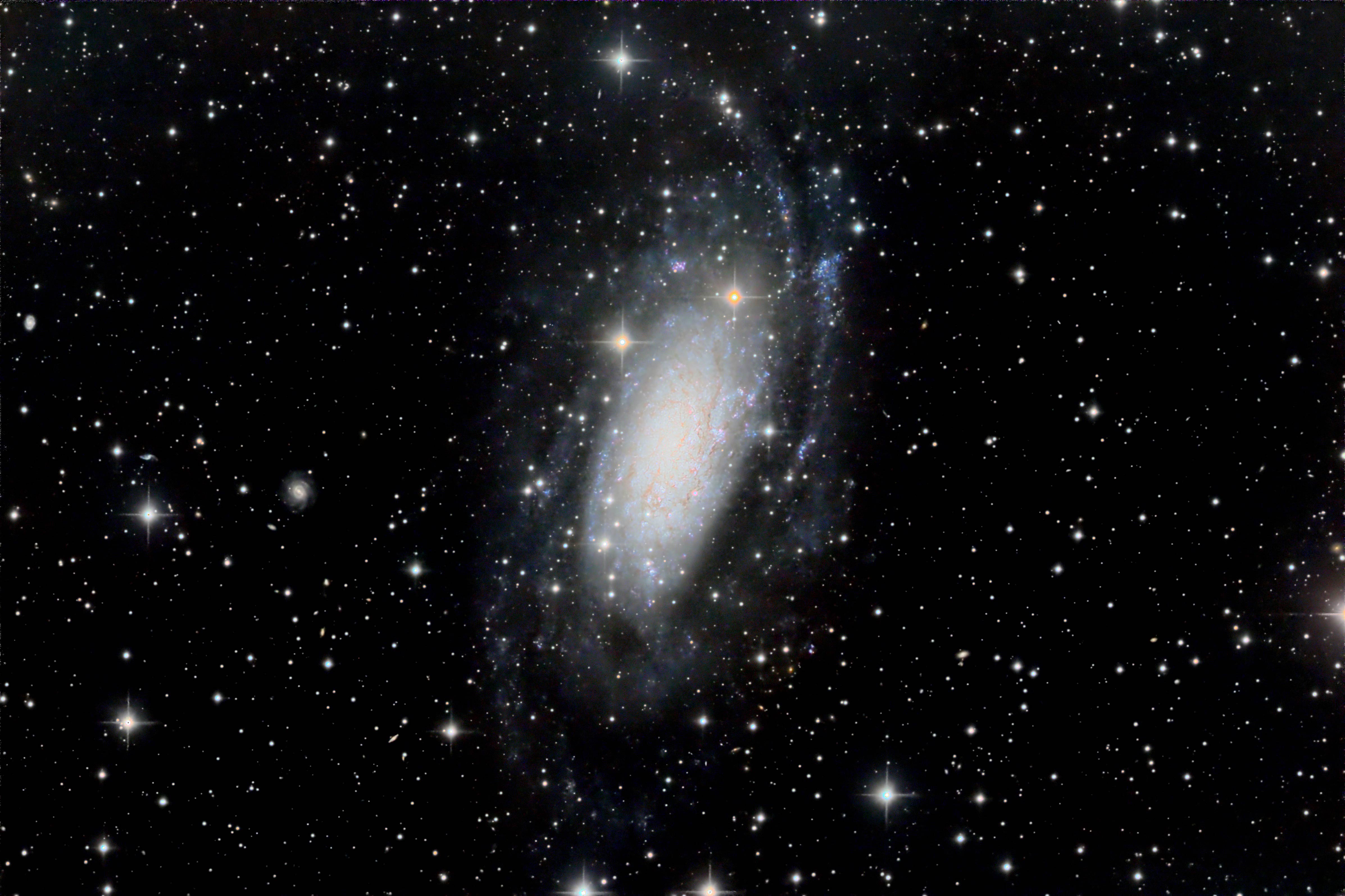 |
 |
| Small Magellanic Cloud This galaxy is one of our neighbors from our local group of galaxies. Officially, It is classified as a an irregular dwarf galaxy and is about 200,000 light-years away from Earth. It has the remnants of a bar structure which means that it was once a barred spiral galaxy. There is a barely visible tidal trail that tells us that it once interacted with the Large Magellanic Cloud. It was once a satellite of the LMC, but is now a satellite of our own Milky Way. It also holds several hundred million stars, and is one of the most distant objects that can still be seen with the naked eye. the large globular cluster to the left is NGC 104, and the smaller globular cluster at the bottom is NGC 362. Image processed by Ron Yelton. Original data from Telescope Live |
Messier 31 (M31) The Andromeda Galaxy This image is a re-do of the one above - the first of probably may - as I improve my processing skills. It's a lot of fun to take an image that I was happy with and hopefully make it better. Another view of the Andromeda Galaxy. This time exploring the center of the galaxy with the 27" Officina Stellare ProRC 700 in Oria, Spain. This galaxy is so bright that you can see it with the naked eye on a clear, dark night. Hence the bright core. Image processed by Ron Yelton. Original data from Telescope Live |
| Location:
Heaven's Mirror Observatory, Australia Date: May 19, 2021 Mount: Paramount MX+ Telescope: Takahashi FSQ-106ED Camera: FLI PL16083 @-25c (AUS-1) (CCD) Exposure: 6 x 5 min ea LRGB Total: 30 min |
Location: IC
Astronomy Obs, Spain Date: Nov 2020-Dec 2021 Mount: OS EQ Telescope: Officina Stellare ProRC 700 Camera: FLI PL16803 @ -25C (SPA-2) Exposure: RGB 10 x 2 min Total: 20 min |
Location:
Date: Mount: Telescope: Camera: Exposure: |
 |
 |